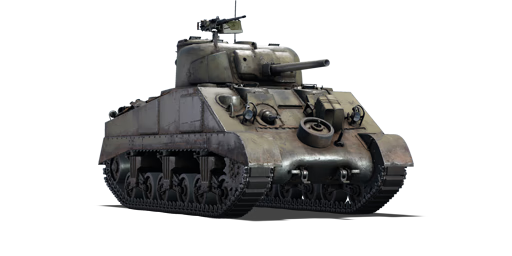Entering production just a month after the M4A1, the M4 Sherman is the second variant of the early-generation Medium Tank M4 (Sherman) family. The Continental R975 radial engine from the M3 and M3A1 light tanks was utilised in the M4 variant. Before the M4 variant even went into production, the great majority of its weaknesses were sorted out. This greatly contributed to the overall M4 Sherman medium tank's reputation for dependability and ease of maintenance. The M4 variant had a welded body and a cast turret that housed the 75 mm M3 tank gun from the M3 Lee. Some early-production M4s have three hull machine guns and two turret-mounted machine guns. The hull weapons were all M1919A4 light machine guns, two fixed and one in a ball mount for use by the co-drivers, but these were quickly removed in the late-production M4s. For practically the entire production run, the turret armament remained unchanged: the 75 mm M3 tank gun with the M1919A4 coaxial light machine gun and the M2HB Browning heavy machine gun mounted on the roof. From July 1942 to January 1944, a total of 6,748 units of the M4 variant were produced, as well as 1,641 units of the modified M4 (105) variant outfitted with a 105 mm howitzer for infantry support. The gun mantlet was improved as well, from the M34 to the more protected M34A1. The turret would be the same as that seen on all early-generation M4 Sherman variants and would be interchangeable.
Introduced in Update 1.45 "Steel Generals", the M4 is the continuation of the M4 Sherman medium tank family. It was painted in the U.S. Army's standard olive-drab green camouflage. The hull of the M4 variant is welded, resulting in a sharper-edged hull shape than the cast hull of the M4A1 variant. All M4 Sherman early-generation variants had the same cast turret and featured a better-protected M34A1 gun mount for the 75 mm M3 tank gun (excluding the M4A1). The glacis of the hull slopes at 56 degrees, as is typical of early-generation M4 Sherman variants. It is vital to pay attention to the hatches that protrude from the hull's sloping contour, as these cause interruptions in the slope and hinder the overall efficacy of the sloped armour. To give additional protection, armour plates are welded in front of the interruptions. However, this remained a significant weakness from the frontal hull context, and most experienced opponents will aim for it. Other highlights on the front glacis include the bundled desert-coloured jerry cans in the driver's region and the road wheel directly on the transmission cover. Furthermore, the additional appliqué armour plates over the sponson ammunition area on the side hull was another distinguishing feature of the M4 Sherman medium tanks. While this provides some protection, it also serves as an indication for the opponent to aim for ammo rack detonation. Overall, the playstyle is extremely similar to all early-generation M4 Sherman variants.















